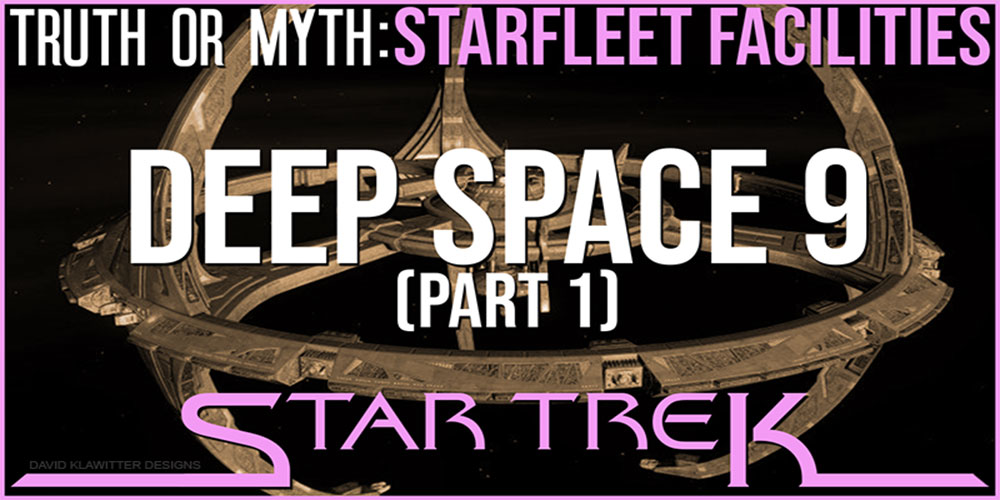Hello and welcome to the Channels Season 5 premiere episode of Truth OR Myth, a Star Trek web series that looks at the Truth, or canon information, to dispel the myths that have surfaced on a given topic. Today’s episode takes us back to Alpha Canon, this time on Starbase Deep Space 9.
An old Cardassian Mining Station, used as an outpost to subjugate the occupied Bajoran Star System, Terok Nor would be abandoned after the Cardassian withdrawal from Bajor and Become Starbase Deep Space 9 for the Federation, and shortly after arriving at this new Starfleet Outpost, Commander Benjamin Sisko and his crew would discover the first stable wormhole known to exist, which would transform almost overnight, this unimportant outpost into a galactic hub that would end up holding all the hopes and dreams for the Federations future. But what was the information behind this station? Well today, we find out…
Since this is an Alpha Canon video, that means that everything stated within the video is fact, and as such been thoroughly researched to ensure it’s accuracy. That being said, DS9’s actual size has never been made canon, as like most trek shows, sizing tends to vary depending on the model shot the episode requires. So to solve this problem what I’ve done is taken the only real references we can get, the Enterprise D docked at the station, and mathematically calculated the approximate size of Deep Space 9, since we DO canonically know the size of a Galaxy Class starship. So although not perfect, it should be rather close to what the in-universe size of the station should be.
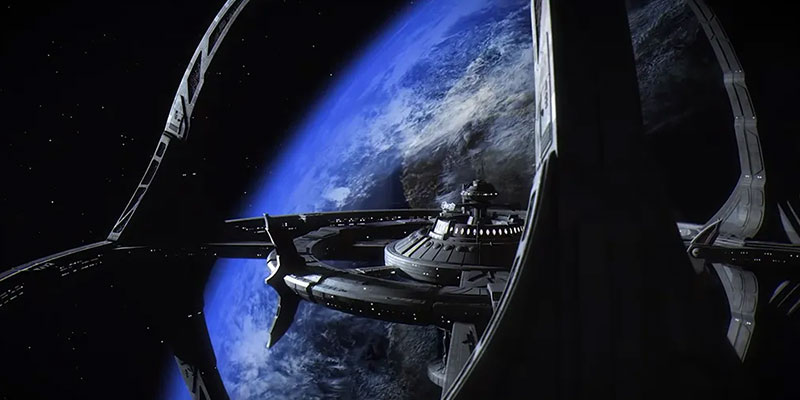
And so, with all that out of the way, let’s begin…
Constructed in 2346, Terok Nor, the name the Cardassian Union gave the station orbiting Bajor, was a mining facility and hub used to oppress the Bajoran People.
The original purpose for Terok nor was to serve as a refinery for Uridium Ore that was mined from Bajor’s surface, a process which meant that Bajoran Slave Labor had to work in temperatures as high as 55 °Celsius. Therefore, Terok Nor had extensive ore refining and transport facilities that were mostly located in the large docking pylon structures and were designed to process up to twenty thousand tons of ore a day.
The station also served as a command post from which the Cardassian Prefect of Bajor, most notably Gul Dukat, oversaw all military aspects of the Occupation of the planet.
In 2369, the Bajoran Resistance would be successful in its quest to have the Cardassian Union withdraw from their planet, freeing Bajor, but the Bajoran Provisional Government quickly realized it simply didn’t have the resources needed to manage the planet back to a self-sufficient state, and fearing the Cardassians might change their mind and return to the planet, immediately sent an urgent petition to the United Federation of Planets for assistance, and the Federation readily agreed.
It is unclear why the Cardassian Union simply left the station for Bajor to assume control of, though many federation historians have theorized that either the Cardassians did in fact intend to return one day to re-occupy the planet and once again use the station as their Occupational Head Quarters, as evidenced by several covert plans uncovered by the Federation intended to force Starfleet in to withdrawing from the Bajoran Sector soon after it had gained control of the station, or that they did in fact set the auto destruct function only to have it either fail or be stopped by persons unknown.
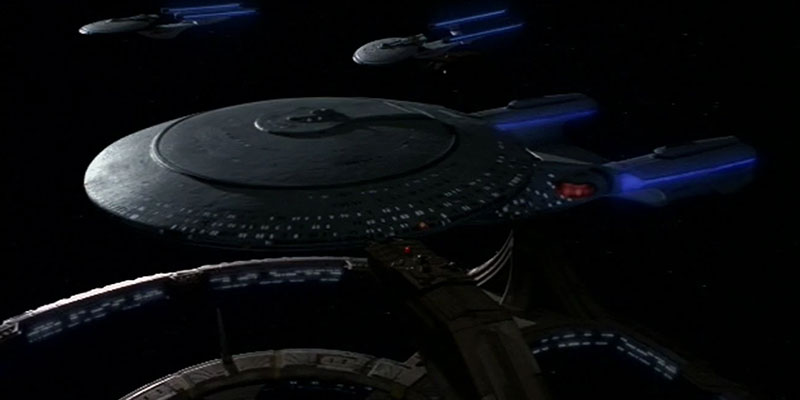
Either way, Starfleet would assume control of the station in early 2369.
Renaming the station from Terok Nor to Starbase Deep Space 9, DS9 stood at a diameter of approximately 1450 meters and was crewed at any given time with between 300 to 2000 crew members. These totals, of course, did not include residents and visitors to the station, which at any given time, could itself add an additional 2-3000 people. Deep Space 9 had a maximum capacity of 7000 people.
6 large docking pylons, 3 upper, 3 lower, would act as the primary docking facility for larger vessels. 3 medium-sized docking ports, and an additional 9 smaller docking ports, would also be available for smaller crafts to dock with the facility. Deep Space 9 also included 6 addition landing pads which were essentially the equivalent to shuttlebays aboard a starship, though these landing pads and bays were much larger than most of the shuttlebays aboard Federation starships.
To keep the station in orbit of Bajor, and later to ensure it maintained it’s position at the mouth of the wormhole, Deep Space 9 was equipped with several control thrusters. These thrusters could also be used to move the station if required.
In fact, in 2369, after the Discovery of a stable wormhole leading to the Gamma Quadrant, the control thrusters would be used in such a manner, though the stations chief of operations Miles O’Brien would have to use the stations deflector generators to create a subspace field around the station to lower it’s inertial mass, this allowed the station to reach the wormhole located in the Denorios Belt on it’s working 6 thrusters far faster then normally could have been achieved.
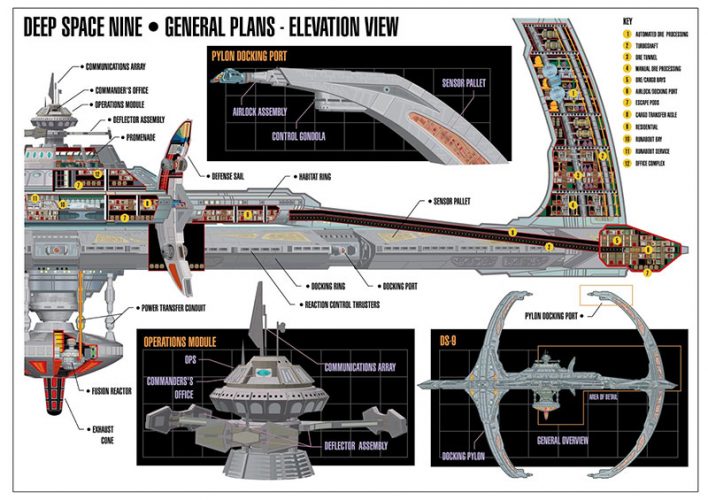
Deep Space 9 was broken up in to 4 main sections, the Central Core, The Habitat Ring, The Docking Ring and the Docking Pylons, The Central Core housed all the main systems of the station. This included Operations, the Command Center of the Entire station, The Central Core was roughly cylindrical in shape, with the Operations Center, Subspace Communications Arrays and Deflector Shield Generators at the top.
Some decks below Operations, was the Promenade, a public area for commerce and recreation. The Promenade on Deep Space 9 housed the station’s infirmary, the security office, a Bajoran temple, and Quark’s, a multilevel bar which also contained several holosuite facilities. Also in the promenade complex was a Klingon Restaurant, a tailors shop, a replimat and several Bajoran Stores. Of course, due to the nature of the business, shops could open, close permanently, move off station or cease to exist at any given time.
The station also featured a wardroom which essentially acted as a briefing room does aboard a Starfleet Starship, though due to it’s size, the wardroom would be used for several other purposes as well such as diplomatic gatherings and a party space. The lower sections of the core contained engineering and support facilities, which included a large industrial replicator facility, the main computer core, and multiple deuterium fuel tanks, which fed the stations six fusion reactors, the main power source of the station.
The habitat ring was the inner ring of the station’s structure, intended primarily to house most of the station’s semi-permanent residents. Spaced along this ring were the stations six landing pads, used by Starfleet’s runabouts and other small craft, also mounted along the habitat ring were three large weapons towers, where most of the armaments of the station were located, as well as its tractor beam emitters. Also located in this section were the station’s weapons lockers, which were on level 5, as well as most of the guest quarters.
The docking ring was the outer ring of the station’s structure, and contained 12 large docking ports distributed around its perimeter, the docking ring also contained the stations massive cargobay complex, having many of the stations cargobays directly connect to the docking port facilities themselves. As this station was originally a mining facility, when Starfleet gained control of Terok Nor it was very lightly armed. Over the next few years, Starfleet would bring the stations armaments up to Starfleet Code, as well as installing an impressive new array of weapons specifically designed for the station to protect it from a possible Dominion invasion.
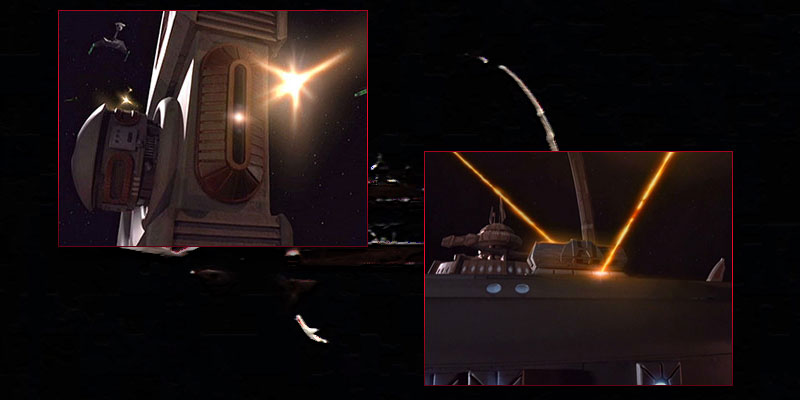
This new weapons array, installed by 2372 included 48 rotary mounted phaser arrays, 36 stationary mounted phaser emitters, 3 additional high powered sliding mount phaser emitters as well as 48 torpedo launchers, and Starfleet Command would supply the station with over 5,000 photon torpedoes. The station’s Deflector Shield System would also receive a major overhaul, though not to the impressive level its weaponry systems had gotten, as Starfleet was still limited by the Cardassian Technology used by the station.
Unlike Starfleet Computer systems, Deep Space Nine’s computer core was considered to be far less compliant then it’s Federation counterparts. Also due to the stations Cardassian Origin, many Federation Systems were simply incompatible with the station’s systems. This meant that Starfleet’s Engineers had to design new components for the station in order to bring several systems up to Starfleet Code, even when Starfleet had decided to upgrade the station’s defences, no one really knew how to do that as Starfleet’s weaponry Systems were again simply incompatible. But eventually, these issues were overcome and the new weapons system were installed.
Deep Space 9 also had a number of support vessels at its disposal. This included several runabouts and eventually the new Defiant-class starship the U.S.S. Defiant. During the first two years of their service, the runabouts were instrumental in the defence of the station and the exploration of the Gamma Quadrant.
During the Federation/ Dominion War of 2373, Deep Space 9 would become one of the Federations most important outposts. Acting as a defence force hub, many strategic operations against the Dominion were planed there, and after mining the entrance of the wormhole in late 2373, to prevent Dominion Reinforcements from reaching the Alpha Quadrant, Deep Space 9 would temporarily fall back into the hands of the Cardassian Union along with their Dominion Allies. But early in 2374, the federation would regain control of the Station a Captain Benjamin Sisko would negotiate a solution to the Dominion Reinforcement Problem with the wormhole aliens, effectively and permanently cutting off any hopes of the Dominion to utilize the Wormhole itself.
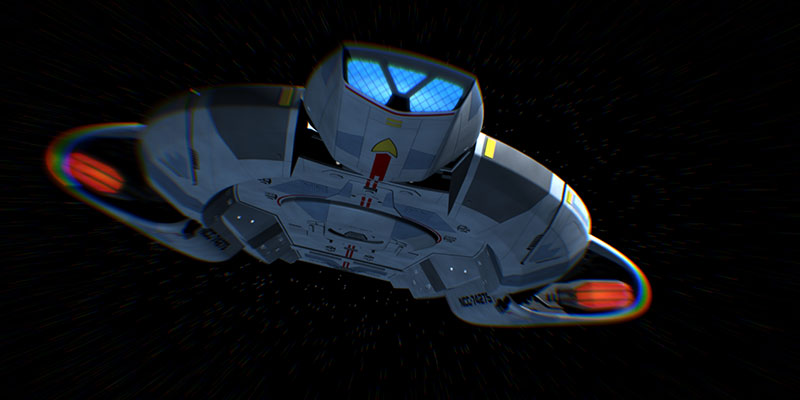
Deep Space 9 would end up proving itself time and time again, becoming a centre of commerce, exploration and eventually defence for the entire Federation. Even the Klingon Empire would acknowledge the importance of the Station, feeling the entire Galaxies hopes rested with that one station.
Deep Space 9 was also important in Starfleet’s continual efforts to contact the U.S.S. Voyager which had been stranded in the Delta Quadrant by providing interstellar phenomena forecasts to Project Pathfinder.
In 2376, The stations crew even predicted that a pulsar would pass close to the MIDAS array. Lieutenant Reginald Barclay of the Pathfinder Project would use this information to finally make direct contact with the stranded starship by creating a micro wormhole.
And even after the Dominion War, Deep Space 9 would continue to play an important role in Galactic Politics, earning this unusual Starbase it’s place, in Starfleet history…
Thank you for watching today’s episode of Truth or Myth, what do you think of the design of Deep Space 9? Do you want to hear more about what happened after the Dominion War with the Station is a series like Star Trek: Picard? Well leave your comments in the section below and don’t forget to like the video and subscribe to the channel.
When we return with part 2 of this series, we’ll take a look inside the station to discover why this design was such an amazing one, so I look forward to seeing you then.
What to help the channel defeat the Jem’Hadar? Then just click HERE to become a channel Patron…
Watch The Latest Truth Or Myth Below
Thanks again for watching, Live long and prosper…

